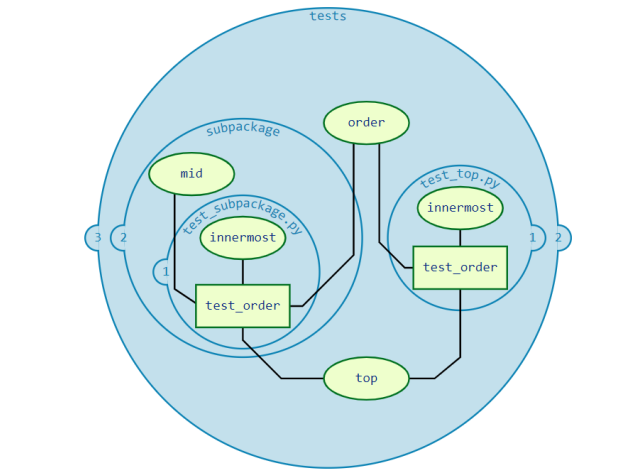这篇文章主要介绍“怎么用pytest解读fixture有效性及跨文件共享fixtures”,在日常操作中,相信很多人在怎么用pytest解读fixture有效性及跨文件共享fixtures问题上存在疑惑,小编查阅了各式资料,整理出简单好用的操作方法,希望对大家解答”怎么用pytest解读fixture有效性及跨文件共享fixtures”的疑惑有所帮助!接下来,请跟着小编一起来学习吧!
fixture有效性,说白了就是fixture函数只有在它定义的使用范围内,才可以被请求到。比如,在类里面定义了一个fixture,
那么就只能是这个类中的测试函数才可以请求。但是,如果一个fixture定义的范围是整个模块,那么这个模块下的每个测试函数都可以去请求。
这里还有另一个影响fixture有效性的参数autouse=True,默认为False,等于True的话会在其他fixture之前先执行该fixture,后面有需要另起一篇,这里简短带过。
另外,一个fixture函数还可以请求任何其他的fixture函数。不管被请求的那个fixture函数在哪里定义,只要测试函数请求了它们,fixture函数就可以。
看示例代码(为了更直观的看效果,在官方代码基础上我加了几个fixture函数的print):
# content of test_module1.py
import pytest
@pytest.fixture
def order():
print("\n运行fixture函数-order")
return []
@pytest.fixture
def outer(order, inner):
print("运行fixture函数-outer")
order.append("outer")
class TestOne:
@pytest.fixture
def inner(self, order):
print("运行TestOne下的fixture-inner")
order.append("one")
def test_order(self, order, outer):
assert order == ["one", "outer"]
class TestTwo:
@pytest.fixture
def inner(self, order):
print("运行TestTwo下的fixture-inner")
order.append("two")
def test_order(self, order, outer):
assert order == ["two", "outer"]注意:
这里有一个fixture函数outer在测试类的外部
另外还有2个名字都叫inner的fixture函数,分别在测试类TestOne和TestTwo中。
在外部的fixture函数outer中,又请求了内部的fixture函数inner。
现在我只运行类TestOne,看运行结果:
test_module1.py
运行fixture函数-order
运行TestOne下的fixture-inner
运行fixture函数-outer
. [100%]
============================== 1 passed in 0.01s ==============================
Process finished with exit code 0说明测试函数里的断言通过。测试函数执行的时候,外部outer请求的inner是TestOne下的。
虽然TestOne类下的inner,只能作用于TestOne下的测试函数。但是,由于测试函数请求了
外部的outer,所以,外部的outer也就可以请到内部的inner。
官方还给出一个示意图,可以结合着上述的思路,理解一下。

注意,fixture定义的范围与它将被实例化的顺序无关:实例化顺序由调用逻辑强制执行(可以参考这篇)。
如果你把fixture函数放到conftest.py文件中,那么在这个文件所在的整个目录下,都可以直接请求里面的fixture,不需要导入。
在实际场景中,我们的测试目录或者包可能有多层的嵌套,这种情况下,每个目录都可以有一个自己的conftest文件。
比如,像这样:

各层级里的内容是这样的:
tests/
__init__.py
conftest.py
# content of tests/conftest.py
import pytest
@pytest.fixture
def order():
return []
@pytest.fixture
def top(order, innermost):
order.append("top")
test_top.py
# content of tests/test_top.py
import pytest
@pytest.fixture
def innermost(order):
order.append("innermost top")
def test_order(order, top):
assert order == ["innermost top", "top"]
subpackage/
__init__.py
conftest.py
# content of tests/subpackage/conftest.py
import pytest
@pytest.fixture
def mid(order):
order.append("mid subpackage")
test_subpackage.py
# content of tests/subpackage/test_subpackage.py
import pytest
@pytest.fixture
def innermost(order, mid):
order.append("innermost subpackage")
def test_order(order, top):
assert order == ["mid subpackage", "innermost subpackage", "top"]同样的,这里也有一张作用域边界图帮助理解。

知识点:
顶层下的conftest里的order和top对当前层和下层级的所有可用(一个圈就对应各自的作用域)。
测试函数只可以向上层级搜索可用的fixture函数(出圈),但是出圈查找的过程中,不能再进到别的圈子向下查找。所以,tests/subpackage/test_subpackage.py::test_order可以找到定义在tests/subpackage/test_subpackage.py里的innermost。但是,另一个定义在tests/test_top.py中,名字也叫innermost的fixture,对test_order来说就不可用了。
其实对于上述,按照我的白话来说,想用conftest里的fixture函数,你只能用同层级或者上层级的。但是上级里的其他兄弟目录或者包,以及他们的下层级的conftest,你是不能用的。
到此,关于“怎么用pytest解读fixture有效性及跨文件共享fixtures”的学习就结束了,希望能够解决大家的疑惑。理论与实践的搭配能更好的帮助大家学习,快去试试吧!若想继续学习更多相关知识,请继续关注亿速云网站,小编会继续努力为大家带来更多实用的文章!
亿速云「云服务器」,即开即用、新一代英特尔至强铂金CPU、三副本存储NVMe SSD云盘,价格低至29元/月。点击查看>>
免责声明:本站发布的内容(图片、视频和文字)以原创、转载和分享为主,文章观点不代表本网站立场,如果涉及侵权请联系站长邮箱:is@yisu.com进行举报,并提供相关证据,一经查实,将立刻删除涉嫌侵权内容。